#cinemaisnotdead
Explore tagged Tumblr posts
Text
The Dust Of Bridgerton - Review
Based on Julia Quinn’s obsessively Jane Austen inspired nine novels, we as an audience step into a world laced with gossip, love and historically inaccurate details.

Regé-Jean Page & Phoebe Dynevor in 'Bridgerton'
Having audiences and the online world jump from their seats at the news of yet another romantically colourful period drama, Netflix’s 2020 Christmas release set off on a high note. However, it may not have been enough satisfaction to cover all viewers, as the overzealous series that is Bridgerton can be perceived as a cute attempt to outline high-society London, rather than a sweepingly romantic love story. From overplayed themes, to the shallow one-liners, saturated costumes and quite frankly, some controversy in a modern series, we’re not so sure that this was a 2020 release. Granted, some of the artistic involvements are wonderfully intoxicating, creating interest and having it for sure be a visual spectacle. Though, this whirlwind historical insight by creator Shonda Rhimes seemed to be a whitewashed teen-drama, instead of a maturely topical period piece.
Based on Julia Quinn’s obsessively Jane Austen inspired nine novels, we as an audience step into a world laced with gossip, love and historically inaccurate details. Set in 1813 Regency London, Rhimes’ series is a period drama surrounding the esteemed Bridgerton family, and particularly Daphne Bridgerton, the eldest daughter of the four sisters. All surrounding the pursuit and importance of finding a suitor eligible for marriage at that time, Bridgerton is the glossed over, trivial version of Pride and Prejudice. Yet there certainly still is wit, charm, enchantment and change, grabbing our attention. It is these themes that we are known to love, rather making Rhimes’ series all the more predictable and repetitive. There is beauty and moments to remember throughout, yet all in all I felt as though I was watching a weak showcase of what a mock Baz Luhrmann and Wes Anderson collaboration that exerted a blinding pastel macaron palette might look like. There isn’t really any distinguishable, first class authentic directing or writing style. We have all seen it before, which is what makes it so popular. Bridgerton’s successful reception does not seem due to the fact that it is a beautifully great show, but because of the fact that it is something written knowing that audiences will not tire of yet another stylish, skinny period drama. We have seen many renditions of Pride and Prejudice, Emma and Madame Bovary over the years, making Rhimes’ series simply another period drama that rather latches onto others for inspiration, rather than being a strong standalone piece.
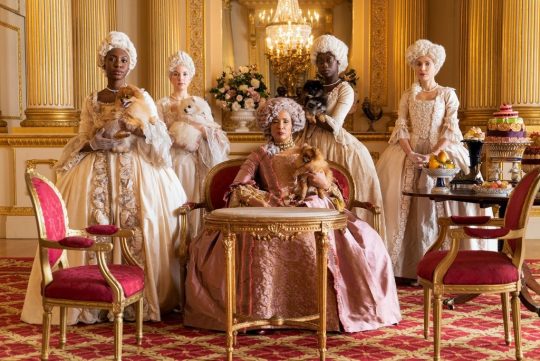
Where Downton Abbey meets Gossip Girl, some might say that this show bursts with fervour, yet it can be deemed as shallow in it’s character development and attempted strong plots. Some might say that Bridgerton has riveting grandeur, but it was films decades ago that originated it so, as we have already marvelled at the magic of the many renditions of Pride & Prejudice. And sure, there is drama, eroticism, as well as there are whispers in the streets filling the scenes of Rhimes’ take on a royal drama. But to have to create excitement by only overdoing sex and violence scenes like this doesn’t speak to highly of it’s quality. And it can be that this is what period dramas are about, yet Bridgerton’s over-embellishment of sex, drugs and rock & roll sometimes paints it out to be taking the easy way out; a cheaply written series by just landing on what is easily stimulating to audiences. As though you’re to a stand up only to have the comedian joke about porn and a night out he might’ve gone on, simply to quickly catch the audiences attention. It works, but does not hold as much substance as a joke with true wit, or in this case, a script with deep quality. The character arc’s end quickly, as does the mystery surrounding who ‘Gossip Girl’-like character Mrs Whistledown is. There isn’t much glory in the drama as there wasn’t enough of it. Yet, the focus on female empowerment and rather the female gaze was something that gets points for originality and undertaking a modern stance during the Regency time period.
Amongst the budding romance, glory and messy undertone of the series, the art department does deserve a pay raise, as there is no doubt that the costumes, set and overall work on Bridgerton make it all the more alluring. In saying alluring, it doesn’t necessary translate as the costumes being convincing. Yet the production and costume design is something that seems to define the esteemed privilege of the characters, as they dress in flashy tulle, silks and organza. Luxurious gardens, ostentatious palaces and velvet furnishings tie into the greatly pleasing aesthetics, as we are given the scoop on the Bridgerton’s drama’s, we also are taken in by their lavish lifestyles. Delicacy after delicacy in the ballroom scenes, as champagne towers flow & rich candles burn. Even in the overplayed sex scenes, velvet carpets and luxurious chaises sit on the backdrop. The combination of bountiful costumes and turns this show into an elevated treat for the eyes.
However beautiful, it can still be said that the costume & set design was just overpowering & seemed like a parody of other period drama’s aristocracy. The sickening yellow-green or floral orange gowns blinded, rather than astounded, as none of the costumes seemed entirely accurate. There are countless YouTube videos on the lack of historical accuracy in the dress. But not only are they inaccurate, they’re just unattractive. The completely saturated colours, ridiculous feathers and overall lack of style is another element that makes Bridgerton just look like a parody of that time period. Yet, cleverly enough, this may have been the point. By creating a romance-drama tale, we step into a fantasy world anyhow, so to change up the costuming can be seen as a good thing, as it does allow us to escape into it. We understand the era, but there is a twist in the aesthetic. If the intention was to accurately represent the time period, then it was far from a success. But if it was to create their own take on it, then it was an interesting move.
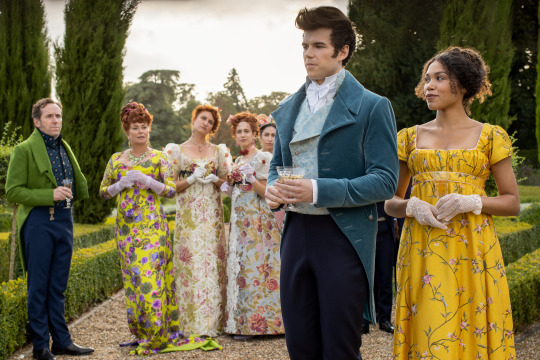
As much as Bridgerton may have looked beautiful, there were certainly bouts of controversy throughout, showing that it may not have been making the progressive impact that it may have hoped to. Rhimes’ twisted world is created & attempts to include actors from different backgrounds, but it rather plays out as just performative diversity. The only main characters of colour are a light-skinned bi-racial man & a snooty looking Asian queen. Obviously and unfortunately historically inaccurate to 1813 London whatsoever, this pursuit to be progressive was admirable, but rather stuck out like a sore thumb & did not blend naturally or seem at all organic. This is because it more so seemed that characters of colour were rather sprinkled in the background with no definitive lines or moments, making even the inclusion of them quite ironic, as it was not fully inclusive, for a show that may have claimed to be diverse. In saying this, of course, along with the blinding costumes and sometimes plastic-like set design, Rhimes’ had created a fantasy version of 1813 London, yet still was unable to do it justice. Colour and race were apart of Bridgerton, but only comfortably and what is suited to the media.
As stringed instrumentals playing Taylor Swift’s ‘Wildest Dreams’ or Billie Eilish’s ‘Bad Guy’, a make a modern take on classical music is made, this change much like the series itself. Whether or not Bridgerton was entirely convincing, it surely still was entertaining amongst all it’s inaccuracy or shallow writing. As to why it was renewed for three further seasons with Netflix, we are not sure. The colour and pompous nature of the series does grab our eye, but cannot hold it for too long, as we may see ourselves comparing it to any other period drama we previously loved. Shonda Rhimes’ ‘Bridgerton’ succeeded in becoming a household name on Netflix, thoroughly captivating and charming, it is a good teen-based and glossed over period piece. When it comes down to good filmmaking with Rhimes’ adaptation of the sprawling novels that Julia Quinn wrote, it really wasn’t all there.
Stars Out of Five: 2.5/5
visit at: dreamsofthescreen.com
#bridgerton#shonda rhimes#phoebe dynevor#costume design#netflix#writersoftumblr#writer#blogger#cinemaisnotdead
2 notes
·
View notes
Photo

The Man Who Wasn't There (2001) . . . 🎬 Directed by: Roger Deakins 🎥 Cinematography by: Joel Coen . . . #movie #moviestill #moviescene #movieshot #movietime #movienight #movielover #movielovers #cinema #cinephile #cinephiles #cinephilecommunity #cineframe #cinematography #cinematographer #filmstill #filmlover #filmlovers #filmstagram #filminstagram #filmmaker #filmmaking #filmframe #cinemaisnotdead #productiondesign #themanwhowasntthere #coenbrothers #rogerdeakins #billybobthornton #joelcoen (at Santa Rosa, California) https://www.instagram.com/p/CBgG4AQFUix/?igshid=xvpv91sz5axq
#movie#moviestill#moviescene#movieshot#movietime#movienight#movielover#movielovers#cinema#cinephile#cinephiles#cinephilecommunity#cineframe#cinematography#cinematographer#filmstill#filmlover#filmlovers#filmstagram#filminstagram#filmmaker#filmmaking#filmframe#cinemaisnotdead#productiondesign#themanwhowasntthere#coenbrothers#rogerdeakins#billybobthornton#joelcoen
0 notes
Photo

Vormax #рефокус ревизия 2 Варио диоптрия для единого фокуса.... .... .... 72мм крепление, 77мм передний фильтр. Идеально подходит для всех бюджетных и компактных анаморфных адаптеров Vormaxlens, а также многих других. Vormax #refocus rev.2 Vario diopter for single Focus.... 72mm mount, 77mm front filter. Ideal for all Budget and compact anamorphic lens and many other lens. #vormaxrefocus #manuallens #lensbible #anamorphic #vormaxlens #vormax #anamorphiclens #anamorphot #lensporn #art #anamorph #photogear #budgetanamorphic #youcanshootnow #cinematographer #cinelens #manualphotography #camerabody #анаморфот #cinemacommunity #cinematography #lensmax #cinemascope #boomstarter #cinemaisnotdead #singlelens #lensculture #focus (at Ivanovo, Russia) https://www.instagram.com/p/B-79h2TBjzE/?igshid=aimtrns0zr2c
#рефокус#refocus#vormaxrefocus#manuallens#lensbible#anamorphic#vormaxlens#vormax#anamorphiclens#anamorphot#lensporn#art#anamorph#photogear#budgetanamorphic#youcanshootnow#cinematographer#cinelens#manualphotography#camerabody#анаморфот#cinemacommunity#cinematography#lensmax#cinemascope#boomstarter#cinemaisnotdead#singlelens#lensculture#focus
0 notes
Text
Alluring or Meaningless? - The Ending of Sorrentino’s La Grande Bellezza (The Great Beauty)
Renowned director Paolo Sorrentino's classic 'La Grand Bellezza' mixes the pathos of life with philosophical ideas, but does its ending even have the desired meaning that audiences were expecting?
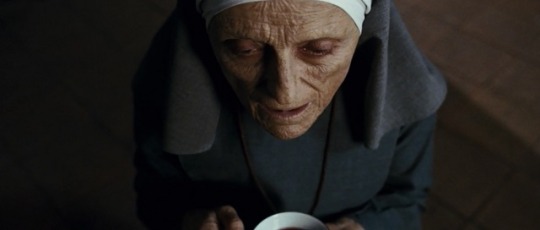
Giusi Merli in ‘La Grande Bellezza’
Paolo Sorrentino’s renowned 2013 Italian modern classic, ‘La Grande Bellezza’ (The Great Beauty) was certainly one for the critics to praise highly, yet there is a certain quality to its largely masterful storytelling that can see it lacking in true depth. Where much of the film’s entirety soars, its value seems to get lost amongst its artsy attempt to create meaning, where it really can appear as overdone and quite hollow. If we look at the last 30 minutes of Sorrentino’s work, we as an audience can certainly debate whether there is awe-inspiring significance or just overplayed rhetoric in the ending of La Grand Bellezza. Where whimsical characters and moments are introduced, viewers can be very easily swept up in Sorrentino’s foreign fairytale, where it really can be deemed as just pretentious. Yet, this point is far from black and white, as ‘La Grande Bellezza’s’ meaning is up to the audience to interpret, still making it a favoured and beloved work.
Italian director Paolo Sorrentino’s works have garnered praise for their dramatic and striking visuals, as well as their convoluted plots. He has been compared to Federico Fellini, and certainly does seem to take inspiration from the 1960s film icon. But Sorrentino is certainly no copy of Fellini, as his culturally inspired films do reach audiences well. Yet where The Academy Awards gave it the win for Best Foreign Language Film, and where critics seem to kiss it’s feet, this doesn’t always mean that it is altogether an expert piece of cinema. You can say that the beauty of film is that it can be totally subjective, which, in hand, is what makes such great art. So us as an audience can ask whether we view the film as more so pretentious or philosophical?
‘La Grande Bellezza’ follows former writer & popular socialite Jep Gambardella, a sort of philosophical muse for Sorrentino. As Jep’s life in Rome is consumed by materialism, it isn’t until his 65th birthday that he begins to look inwards. This leads him on a search for ‘the great beauty’, which has him relishing in nostalgia and existential simplicity, audiences closely following behind on that journey with him. The greater part of Sorrentino’s film does successfully have us questioning our place in the world, and where our values lie. Through comparing and contrasting the superficial high life with what’s most important to humanity, we are reminded of our own perspectives on what does and should hold the most substance or meaning.
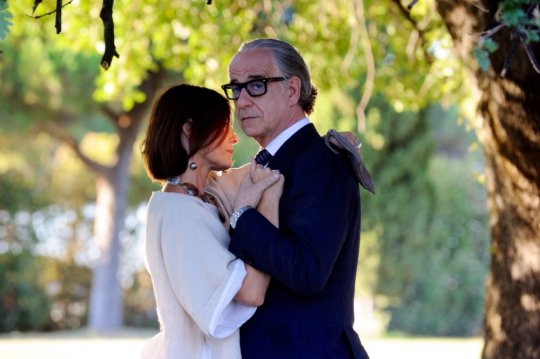
Toni Servillo in 'La Grande Bellezza'
Yet as Jep has wandered around searching in different areas for beauty in truth and philosophy, his defining moment seems to be towards the end of the film, when he is introduced to Saint, Sister Maria. As Jep is told that she had ‘read his novel & loved it’ years before, we are left open to interpretation to who this Saint may be. Yet the answer in itself is somewhat disappointing. Again, it is not to say that the ending of Sorrentino’s film is wrong or terrible, but is surely very thought provoking.
This moment starts in the last thirty minutes of the film, and we are never given a backstory to Sister Maria when or before she is introduced. And she is introduced, literally, on a pedestal. As she sits there in silence, she wears a dusty, grey-blue nun’s habit, her olive skin lined with deep wrinkles, and expression truly dried out. Members of high society kneel to her, kissing her hands. In the chapel that she sits, there are priests, monks, African tribesmen and all in all, only established figures flocking to her, their eyes wide in honour of her presence. It is as though these figures are all awaiting an answer that they cannot find, and seek out from Maria. Though she is established as a wise old prophet with supposed life-changing aid, what makes her so respectable? She appears as though she has lived three lifetimes and has ‘only granted three interviews in all her life’, yet this alleged messiah altogether utters very little meaning. Sister Maria’s introduction has her appearing as a monumental figure, mostly due to the filmmaking aspects of the scene. In the chapel, lit with a chiaroscuro inspired light, along with medieval Roman Catholic music echoing throughout, with the purpose of warming our hearts. Contemplative looks from across the room, including a black priest, may be there to show the diversity that Maria is surrounded by, as those across the globe seem to adore her. The only interpretation gathered is that Sister Maria is an attempt to create a grandiose moment to close out the film in a profound sense. Yet what I’d gathered of this Saint, is that she lives so austerely that Sorrentino’s ending becomes muddled and pretentious.
As previously mentioned, we are never given a backstory to Sister Maria, but maybe that is the beauty of it that Sorrentino was trying to portray. This icon in the film is looked up to for her granted simplicity. But by portraying something so obscure, Sorrentino’s work doesn’t always appear as interesting, but as an attempt to do so. Is it her goodness or her stripped back way of living that those aspire to? And why does it need to be members of high society that only seek her advice? Wouldn’t Sorrentino’s inclusion of ordinary citizens make it all the more realistic, or relatable and grounded, rather than once again getting caught up in something so grand?
Her grandeur is never explained, to which we can be inspired or simply baffled by the mystery, seeing it as something that creates interest, or just remains pretentious. Yet even if her significance was explained, and made this supposed icon as meaningful as someone like the Pope or Mother Teresa, aren’t we supposed to be inspired by the ordinary and the beauty in simplicity. Isn't the point of 'La Grande Bellezza' to celebrate the simple things in life, rather than an established, worshipped figure? The portrayal of this kooky character tries to make a point towards being so well grounded, that it is absurd. As she speaks to Jep, she asks 'Do you know why I only eat roots?', to which Jep asks why, her response following as, 'Because roots are important'. Now Sister Maria's actions line up with her values and grounded nature, as she genuinely decides to eat roots. This can be seen by some as profoundly inspiring, but is altogether quite a weak attempt to deliver an overly-artistic message. And sure, it isn't all pompous, as there is a great reference to the Catholic influences in Italy and the holy hierarchy of Rome & it’s art. But it is the aureate expression doesn’t sell it as being moving, but is instead simply too showy.
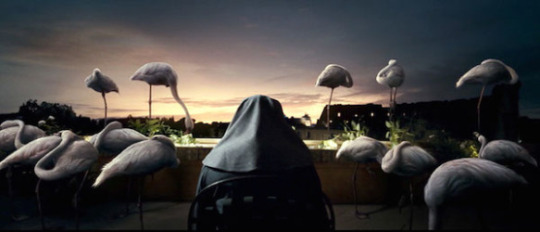
When sat down at dinner with Jep and his fellow members of Roman high society, Maria is slouching at the head of the table with a vapid expression. The attempt at meaning that Sorrentino has so clearly tried to create is open to interpretation, yet it can be said that this is not one of the his finest writing moments. Sister Maria does not speak a word, and whenever she does, it is a brooding comment that is supposed to hold substance, but instead can be regarded as pretentious. The moment she lifts her head to comment on Jep's novel, all eyes are so enthusiastically on her. Sister Maria does not sleep in a bed, as she finds Rome’s 5 star Hassler hotel, ‘uncomfortable’. Her perspective on life can be seen as purely existential and somewhat nihilistic, or greatly generous. As she works alongside the sick and supports the Third World, her abandonment of any enjoyment and subscription to poverty has us question our place. Is someone really so empathetic that they’ll refuse any comfort, because others are worse off? Again, Sorrentino does succeed in communicating a message that has us asking questions like this, yet the point is too greatly emphasised through the worshipping and dramatically overdone expression of this holy character.
As Jep focuses on switching his hedonism for eudaemonism, his perspective on the finer things in life is the things he used to have, leading him to relish in nostalgia. Sister Maria seems to be an exaggerated symbol of his changing philosophy, as well as a turning point for him to once again write, after abandoning any such creativity for decades.
Something in meeting Sister Maria has Jep retuning to Giglio Island to report on a shipwreck, again, quite symbolic of Jep’s career position, having not written a novel in 40 years. Here, he remembers his first meeting with his first love, to which inspires him to write again. Apparently Sister Maria is the bridge between Jep’s despair & newfound hope.
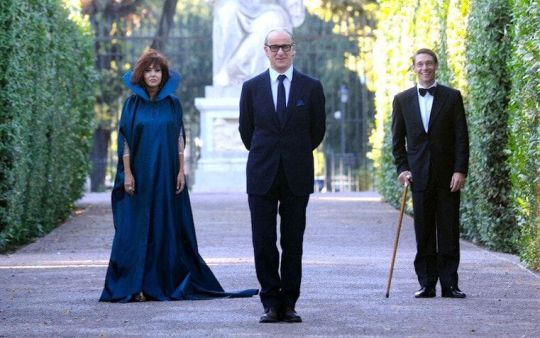
Paolo Sorrentino's expertly expressive film is a no doubt a masterful passion project that communicates the pathos and joy of the human condition, impacting audiences greatly. Yet Sorrentino's attempt to create something meaningful to close out an already wonderful film filled it with more vanity than it needed. It is an entirely subjective work that involves the audiences thought and we can all interpret it how we see it, which is assuredly a good thing. However, Sorrentino’s quite bombastic ending was just a questionable cliffhanger and didn't line up with the greatness that the first two hours of 'La Grande Bellezza' provided. Though a fantastic feature, Paolo Sorrentino seemed to get too lost in portraying a message so obscurely overdone, that it had somewhat lost it's original meaning.
visit at: dreamsofthescreen.com
#cinema#writer#blogger#bloggersoftumblr#italianfilm#philosophy#cinemaisnotdead#cinematography#worldcinema#italiancinema#la grande bellezza
3 notes
·
View notes
Text
The Artistic Way of Edith Piaf - La Vie En Rose Analysis & Review
The sad starlet is portrayed so perfectly it hurts; La Vie En Rose bursts with life and emotion

Marion Cotillard in ‘La Vie En Rose’
Though there may be some critiquing of Olivier Dahan’s supposedly disordered storytelling, it is the performance of Marion Cotillard that makes ‘La Vie En Rose’ an outstanding classic. The purely harsh portrayal and music of Piaf combined with Cotillard’s more than Oscar-winning acting sets a tragically beautiful tale for a piece of world cinema. There may be a cultural divide between what non-European audiences classify as a convincing film, but as far as a French standout film goes, Piaf’s renowned biopic hits the nail on the head fourteen years later. As we are given a myriad of moments in the icons life, us as an audience are impacted, and therefore can question our position in the world. It is this inspiration that sets a film on a high pedestal, with ‘La Vie En Rose’ certainly ticking that box.
Born Edith Giovanna Gassion, she is introduced as the daughter of a busker and acrobat, soon dumped at a brothel. Abandoned by her mother and dumped on the doorstep of prostitutes by her father, the opening to Edith’s life has no glory. Yet the icon is born when she is hoaxed into performing on the sidewalk. Her father commands her to “do something”, and thus she sings a breathtaking rendition of ‘La Marseilles’. The magic of the film is highlighted in the elemental jump cuts to and from Piaf’s life. Yet the problem with ‘La Vie En Rose’ only lies in the critical response to it, as some audiences seemed to have a problem with the lack of chronological order in director Dahan’s storytelling. In an article for the Guardian, English writer Peter Bradshaw had ‘La Vie En Rose’ coined as ‘formless and weirdly selective’. Yet, I don’t find it formless or uninspiring, as these moments in time suggest the importance of memory, nostalgia and the everpresent fade of life, especially in Piaf’s. Though not as orthodox as a usual biopic, and I understand the confusion in choosing to leave out Piaf’s WWII years, yet was there really enough time to include every facet of Piaf’s life, unless Dahan were to meaninglessly speed and skim over every year of the songstresses career.
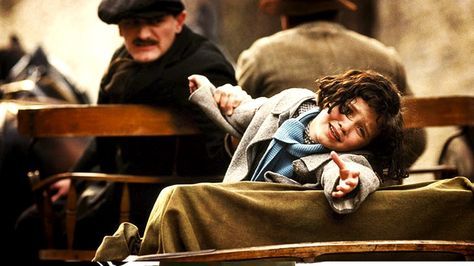
Manon Chevallier in ‘La Vie En Rose’
And sure, it didn’t show every step of Piaf’s journey, but instead opted for personal, touching and deeply tragic moments that formed Edith and her career. By delving deeper into certain moments, audiences can appreciate both the juxtaposition and contrast of showing Piaf’s early life and beaming end. As she runs through the streets of Paris in her twenties, we also simultaneously see a decrepit Edith in bed, and at death’s door. Where Dahan was to make an emotional statement to define the treacherous nature of Edith’s life, some critics found it boorish. However much the artistically cut presentation of Dahan’s story doesn’t appeal to every audience type, it is this cinematic style that positively sets it apart.
Described by American critic Richard Roeper as ‘a surreal and exhausting experience’, it can be said that selective audiences possibly found it too harsh. Yet it’s harshness is what makes it so great and so astoundingly cutting. Where American audiences found Piaf to be more intimidating than beautiful, Edith’s arrival in New York City has her reflect on this, as she says ‘Americans want beauties, not me. I’m not the Parisian bombshell they expected’. The cultural divide between what American audiences expect, not only in musicians of the 1930s, but in film today, is to have a pristine and glorified fairytale ending. The European way of looking at things is to bring some severity and realism to the table in order to fulfil the meaning and wretchedness in a true story. ‘La Vie En Rose’ is a fantastic example of just this. Yet it cut through & still soared in the United States. Winning three Academy Awards for Best Actress, Best Makeup and Hairstyling, as well as Best Costume Design, it’s success did reach international heights, inspiring audiences across the globe.
The brutality of Piaf’s journey is characterised by the endless cycle of unfortunate events. And though the title suggests positivity, the painful contrast is that Piaf’s life was far from rosy. As American’s view tales of rags to riches with as a Cinderella moment-styled turn around, Piaf’s lifetime shows us the pursuit and changes of a tortured artist. This is something that we, and foreign audiences like Americans, need to be reminded of in order to immerse ourselves into empathy and the reality of a life lived. It is the classic tale of treachery in an artists life throughout the ages - from Van Gogh to Sylvia Plath to Edith herself.

Thanks to the indisputable talents of Marion Cotillard, the sad starlet is portrayed so perfectly it hurts, having ‘La Vie En Rose’ burst with life and emotion. Richard Nilsen from Arizona Republic quotes Cotillard’s stellar performance as Edith Piaf in regards to the Academy Awards, stating “don’t bother voting. Just give the Oscar to Marion Cotillard now…her acting is the most astonishing I’ve seen in years”. And it is true, Cotillard was a scarily perfect fit for Piaf, as she tailored herself to Piaf’s throaty song and fiercely sensitive expression. There is no trace of Cotillard, as the physical transformation into Piaf is astounding. Every element of passion, pain and change is utilised to the fullest, making it the performance of a lifetime. Heart, body and soul, she is there as Edith, committing all and all to the nature of the iconic musician. Cotillard’s portrayal of Piaf’s indulgence in the finer things in life, do really equate to the classic sex, drugs, rock & roll complex of an thus, leading her into some pretty gripping dramas.
It is difficult to pick a standout scene, as in every element of the film, Cotillard exemplifies Piaf’s character. Yet there are memorable moments that define as to why she was more than deserving of a mere Academy Award. Piaf (spoiler alert) learns the news of the death of her already wedded professional boxer boyfriend, Marcel Cerdan. It is the twist of emotions, understanding of psychology and pain that Cotillard brings that makes it unlike any performance I, and many audiences had ever witnessed. This scene is entirely shot in a single take, having Cotillard act with no moment to reevaluate. As Piaf circles the lavish, yet simple accomodation in an attempt to look for Marcel’s watch & ignore any impending sense of doom, she loses it. Cotillard’s utterly devastating emotional expression transcends any language or culture, making a scene that can be defined as straightforward into one of the most heartening in film history. Followed by Cotillard’s shaking limbs and spine-chilling sobs, she is overtaken by the playing of her own impassioned music, as she glides back onto stage, signifying her return to music in times of pure distress. To say that Cotillard’s performance was overwhelming or overdramatised isn’t a vital statement, as given Piaf’s tumultuous life and harsh French attitude, she very likely was as she appears. Cotillard’s work does nothing as such to glorify or mystify Piaf, as we are presented with the continued trauma that is laced into the songbird’s life.

If we are to talk about the artistic elements of Dahan’s Piaf biopic, the mix of all departments are what contribute to the beauty of such a powerful story. The sweeping camera movements and overall cinematography choices successfully work, showing us differing perspectives of Piaf’s extraordinary life. This, combined with the Oscar-winning hair, makeup & costume, alongside the professionally beautiful and changing aesthetics throughout only make this journey a heck of a lot more captivating. We watch the remarkable mix of scenes in the final sequence of Piaf’s last moments. Dahan captures every side of a musical legends excruciating life. We see the grandeur and iconic status of Edith in her late career, wistfully singing ‘Non, je ne Regrette Rien’, along with the innocence of childhood in a young, melancholy Piaf standing in an empty field, all while next to her in her final moments, in bed and fading peacefully. The Piaf-heavy soundtrack is a great win, as the most iconic songs are played when Cotillard’s Edith performs onstage, or utilised to support the emotion in the film, blending beautifully together. Along with this, the set design is also exquisite, exuding both the decrepit nature of a young Edith’s life as a girl from the streets of Paris in the early 1930s, to the uplifted European, artistic elegance of a five-star lifestyle. We are given cultural insight into the European way of beauty - love, loss, visual arts and the rollercoaster of emotion. There is no shortage of interest or classic artistic fulfilment in each area of expression, again, only establishing such a well-rounded, cutting film with passion in every element, having it not miss a beat of creativity.
Even more in the artistic sense of film, it is how we react to and are shaped by cinema that characterises an important film. Within Dahan’s interpretation of one woman’s life, we are not only inspired, but given a philosophical approach. Though we see it as a greatly disparaging piece of film with tragedy as the main theme, there is a great deal of hope and resonant beauty in the artistic approach that Dahan takes in characterising Piaf’s gruelling life. Cotillard has Piaf appear as both doomed and reflective, her life equating to a lesson on the unexpected nature of life. Whilst we are sometimes told sentiments like ‘everything happens for a reason’, where do we step in with our faith or spirituality when there is nothing but mercilessness around a life like Edith’s? Audiences can take a step back to think about their own position; to be grateful and consider the ephemeral nature of life. We simply are given an elevated reminder of the deeply contrasting emotions and arduous nature of living. The optimism in Piaf’s music both reflects and contrasts the treachery of and deep changes in Edith’s life.
Though we have Edith sitting in beautiful rooms and attending champagne-budget dinners, surrounded by loved ones, she is still haunted by the pain and anger that was left in early childhood. Yet, at the end of the film, she sits on a beach with an interviewer, as she is asked ‘If you were to give advice to a woman, what would it be?’ to which she responds, ‘love’, & as the journalist follows up with, ‘to a child?’, she says ‘love’. Upon reflection and a life lived, Edith still has human emotion and core values left. The way of art is to portray the beauty and pathos of life, to have us question and interpret. To get to do that through entertainment is only another luxurious step up through Dahan’s haunting tale.

Heart and soul I can surely say that ‘La Vie En Rose’ is one of, if not, the most astounding biopic and piece of cinema in the history of film. The criticism doesn’t deserve credit as every available space is filled in the most, theatrical beautiful sense. As a Francophile myself, the artistic way of ‘La Vie En Rose’ is in it’s painful expression, alongside the cutting-edge work of Marion Cotillard. For a film to both enjoy the elegance of and detest the cruelty of Piaf’s existence, it’s emotion transcends many cultural barriers. Nevertheless, we are impacted within every spark and tear a tortured artist through Olivier Dahan’s winning 2007 biopic.
Stars Out Of Five: 5/5
visit at: dreamsofthescreen.com
#edithpiaf#cinema#cinemaisnotdead#writers#writersoftumblr#blogger#frenchcinema#artcinema#worldcinema#2007film#2000sfilm#aesthetics#marion cotillard
1 note
·
View note